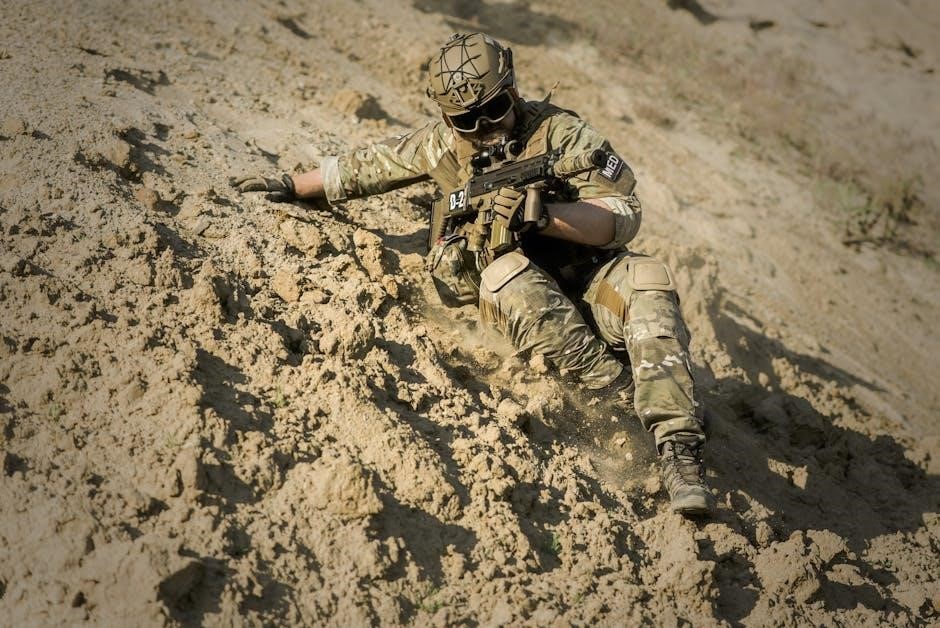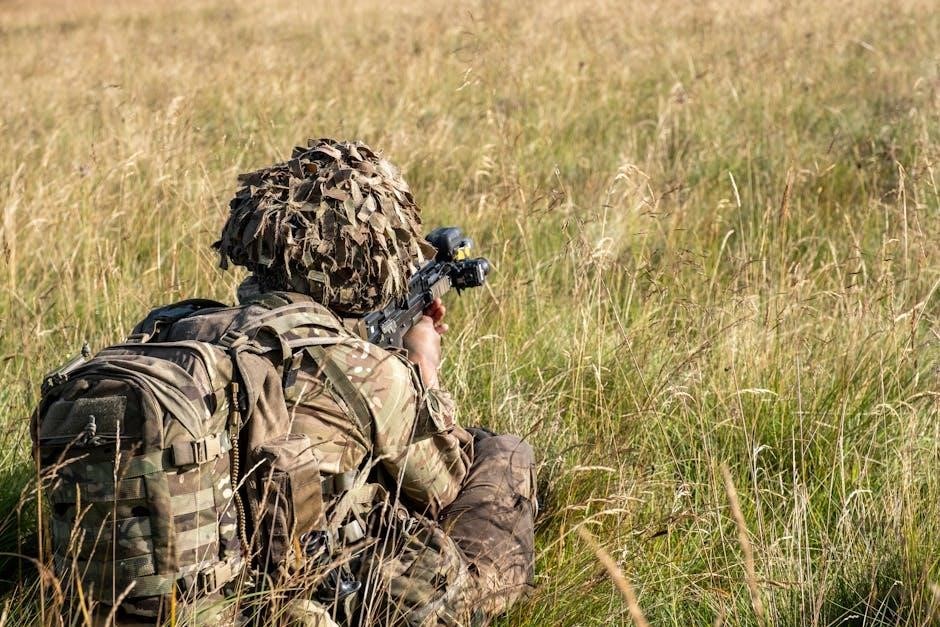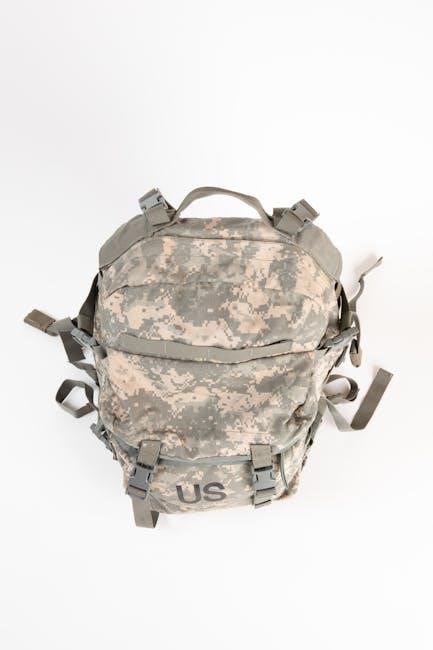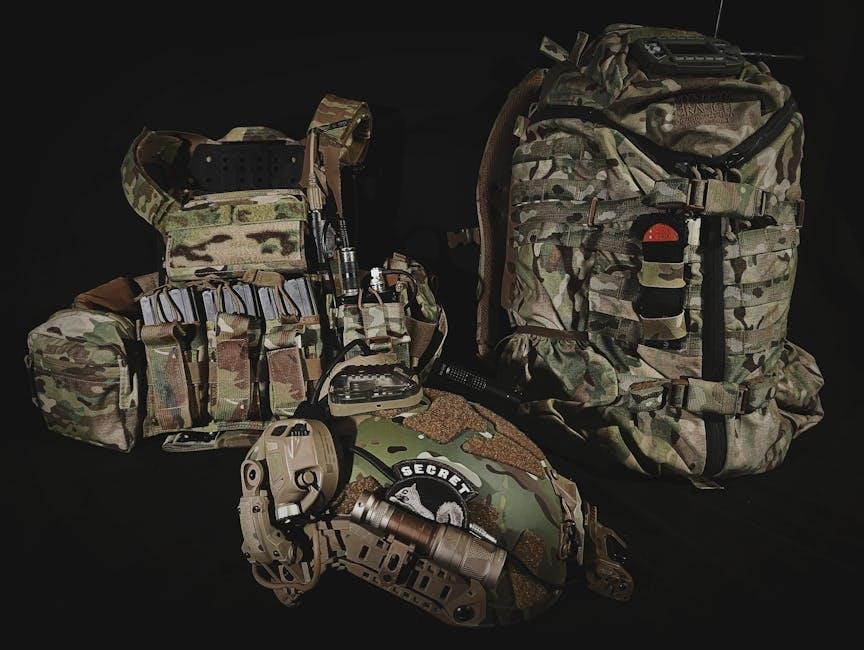The U.S. Army Survival Manual FM 21-76 is a comprehensive guide offering field-tested techniques for survival in extreme environments. It provides essential strategies for self-reliance and resilience.

Overview of the Manual’s Purpose and Importance
The U.S. Army Survival Manual FM 21-76 serves as a critical resource for teaching survival skills in extreme conditions. Designed for military personnel, it provides field-tested strategies for staying alive, finding food, and navigating challenging terrains. Its importance lies in its practicality, offering actionable advice for real-world scenarios. While originally intended for soldiers, the manual has become a valuable tool for civilians seeking to enhance their survival knowledge. Available online, it remains a go-to guide for anyone preparing for emergencies or wilderness adventures, ensuring self-reliance and resilience in the face of adversity.

Key Components of the Manual
The U.S. Army Survival Manual FM 21-76 encompasses essential survival skills, including water procurement, shelter construction, and fire starting. It details techniques for finding food in the wild and signaling for rescue. The manual also covers psychological aspects like maintaining a positive attitude and managing fear. Additionally, it provides guidance on first aid, preventing infections, and navigating without a compass. Practical tools like creating field-expedient navigation aids are included, ensuring comprehensive preparation for survival situations. These components make it an indispensable resource for both military personnel and civilians facing extreme challenges.

Understanding the Environment
The manual emphasizes assessing terrain and climate to identify natural resources, crucial for survival. It teaches how to adapt to diverse environments effectively, ensuring resource utilization and safety.
Assessing Terrain and Climate
Assessing terrain and climate is crucial for survival. The manual teaches identifying high ground for visibility, low areas for water sources, and avoiding natural hazards. Understanding climate types—arid, jungle, or temperate—helps in resource allocation. Recognizing seasonal changes and vegetation patterns aids in locating food and shelter. Terrain assessment includes evaluating slopes, valleys, and potential escape routes. Climate awareness involves preparing for extreme temperatures, precipitation, and wind. These skills enable individuals to adapt to their environment, ensuring safety and resource efficiency. Proper terrain and climate assessment are foundational for all survival strategies outlined in the manual.
Identifying Natural Resources

Identifying natural resources is essential for survival. The manual emphasizes locating water sources, such as streams, ponds, and springs, and identifying edible plants. Soldiers are taught to recognize plants safe for consumption and avoid poisonous ones. Wildlife, like birds and small animals, are highlighted as potential food sources. The manual also covers using natural materials, such as trees and rocks, for shelter and tools. Understanding how to repurpose these resources maximizes survival chances. Proper identification ensures safety and sustainability, making natural resources a cornerstone of survival strategies in the field.

Survival Psychology
Survival psychology focuses on mental resilience and the will to survive. It emphasizes staying calm, focused, and determined, which are crucial for overcoming challenges and maintaining physical health.
Maintaining a Positive Mental Attitude
Maintaining a positive mental attitude is vital for survival. A resilient mindset helps overcome fear, anxiety, and despair. Focus on setting realistic goals, staying organized, and avoiding negative thoughts. Cultivate self-confidence by recalling past successes and staying determined. If in a group, encourage teamwork and mutual support. Establish routines for daily tasks, including personal hygiene, to maintain discipline. Remind yourself that survival is temporary and help will arrive. A positive attitude strengthens your will to survive, enabling you to adapt and thrive in challenging environments. Mental resilience is as crucial as physical preparedness in overcoming adversity.
Understanding Fear and Stress Management
Fear and stress are natural reactions in survival situations, but unmanaged emotions can impair judgment and decision-making. Recognize that fear is a normal response, but it must not control actions. Stress can lead to fatigue, confusion, and poor concentration. Manage these emotions by staying focused on immediate tasks and breaking challenges into manageable steps. Practice deep breathing or meditation to calm the mind. A clear and disciplined mindset ensures better problem-solving and resource allocation. Learning to control fear and stress enhances resilience and increases chances of survival. Proper training and preparation build confidence, reducing the grip of anxiety in critical moments;

Essential Survival Skills
Mastery of core survival skills is critical for staying alive in hostile environments. These skills include water procurement, shelter building, fire starting, and signaling for rescue effectively.
Water Procurement Techniques
Water procurement is vital for survival, requiring knowledge of reliable sources and purification methods. Techniques include locating streams, ponds, or rainwater collection. Transpiration methods, such as tying plastic bags around leaves, can extract water from plants. Solar stills are effective for purifying contaminated water. Always prioritize purifying water to avoid waterborne illnesses. Use methods like boiling, sand filtration, or disinfection with iodine or chlorine. Conservation is equally important, as dehydration can occur quickly. Proper water procurement ensures hydration, maintaining physical and mental performance in survival situations. These techniques are fundamental to sustaining life in the field.
Shelter Construction Methods
Shelter construction is critical for protection from extreme weather and wildlife. The US Army Survival Manual outlines various methods, such as building debris huts, lean-tos, and snow shelters. Natural materials like branches, leaves, and snow are essential. Look for sturdy trees or rock overhangs as frameworks. Ensure proper drainage to avoid flooding. Camouflage shelters to blend with surroundings for concealment. The goal is to create a structure that provides insulation, reduces wind exposure, and safeguards against environmental hazards. Proper shelter construction enhances safety, conserves energy, and boosts morale in survival situations. It is a fundamental skill for enduring hostile environments.
Fire Starting and Maintenance
Fire starting is a vital survival skill, providing warmth, light, and a way to cook food. The manual emphasizes using materials like dry leaves, grass, and small twigs as tinder. Flint and steel, bow drill, and solar firestarting methods are recommended. Once lit, fires require proper maintenance to sustain them. Ensure good ventilation to keep flames strong and conserve fuel. Clear the area of flammable debris to prevent accidental spreads. Fire starting and maintenance are essential for boosting morale, signaling for help, and staying safe in harsh environments. Mastering these techniques is crucial for survival;
Signaling for Help and Rescue
Signaling is critical for rescue in survival situations. The manual highlights methods like creating smoke signals during the day and building large fires at night. Use reflective objects, such as mirrors or metal, to flash sunlight toward rescuers. Three short whistle blasts signal distress. Construct ground signals like “X” or “HELP” using rocks or logs. Stay visible by wearing bright clothing and positioning yourself near signals. Signal fires should be built in a triangle formation for maximum visibility. These techniques increase the chances of being spotted by rescue teams, making signaling a lifesaving skill in emergencies.
Food Procurement and Preparation
Procuring food involves foraging, hunting, and fishing. Ensure food safety by identifying edible plants and properly cleaning animals. Cook thoroughly to avoid undercooked meat or plants.

Finding Food in the Wild
Finding food in the wild requires knowledge of edible plants, animals, and insects. Forage for berries, nuts, and greens, ensuring they are safe to eat. Hunt small game like rabbits or birds using traps or makeshift weapons. Fishing is another reliable method, using improvised hooks or nets. Insects and crustaceans are also viable sources of protein. Always avoid poisonous plants or animals, and cook food when possible to kill harmful bacteria. Use field-expedient tools like traps or snares to conserve energy. Knowledge of the environment and animal behavior is key to successful foraging and hunting in survival situations.
Preparing and Cooking Wild Food
Proper preparation and cooking of wild food are crucial for safety and nutrition. Clean and skin animals, removing organs and blood to prevent spoilage. For plants, wash thoroughly to eliminate dirt or toxins. Cooking methods include roasting over a fire, boiling in water, or steaming. Use makeshift utensils like sticks or stones for handling food. Ensure meat is fully cooked to kill bacteria. Fish can be grilled or smoked for preservation. Insects should be roasted or boiled. Avoid undercooked meat to prevent illness. Proper food preparation enhances flavor and ensures safe consumption in survival conditions.
First Aid and Health
First Aid and Health involves assessing injuries, treating wounds, and preventing infection. Use available resources to promote healing and maintain personal hygiene in survival conditions.
Treating Injuries and Wounds
Quick and effective treatment of injuries is critical for survival; Always prioritize stopping bleeding first using tourniquets or pressure dressings. Clean wounds thoroughly with safe water to prevent infection. Apply antibiotic ointment if available and cover with a sterile dressing. For fractures or sprains, immobilize the affected area using splints made from readily available materials like branches or clothing. Monitor for signs of infection, such as redness or swelling, and reassess the injury regularly. Proper wound care and immobilization are essential to promote healing and maintain mobility in survival situations.
Preventing Infections and Diseases
Preventing infections is crucial for survival. Always maintain strict hygiene standards, especially when handling wounds or food. Use safe water for drinking and cleaning to avoid waterborne illnesses. Apply antibacterial ointment to minor cuts and abrasions to prevent infection. Keep living areas clean, and avoid contact with contaminated materials. Wear protective clothing and use insect repellent to reduce the risk of insect-borne diseases. Ensure food is properly cooked and stored to avoid spoilage. Regularly inspect gear and shelter for signs of mold or pests. These practices significantly reduce the risk of illness and maintain overall health in challenging environments.

Navigation Techniques
Mastering navigation is vital for survival. Techniques include identifying landmarks, using celestial bodies, and creating mental maps to stay oriented and locate destinations efficiently.
Finding Direction Without a Compass
Finding direction without a compass involves using natural signs. The sun rises in the east and sets in the west, providing basic orientation during daylight. At night, the North Star (Polaris) indicates north, located through the constellation Ursa Minor. Shadows can also help; stick a straight object in the ground, mark the shadow tip, and after some time, the line between the two marks will run east-west. These methods, while simple, are effective for determining direction in survival situations. Always cross-reference multiple signs for accuracy to ensure proper navigation.

Using Natural Signs for Navigation
Navigation using natural signs involves observing the environment to determine direction. The sun’s position is a key indicator: it rises in the east and sets in the west. In the northern hemisphere, the North Star (Polaris) remains nearly stationary in the northern sky, indicating north. Moss growth, though not always reliable, often thrives in shaded, damper areas, which can sometimes suggest north. Vegetation patterns and the direction of slope can also provide clues. By studying these natural signs, soldiers can enhance their navigation skills and remain oriented in the field, even without modern tools.
Creating Field-Expedient Navigation Tools
Field-expedient navigation tools are essential for soldiers to navigate when modern equipment is unavailable. A makeshift compass can be made by magnetizing a needle and floating it on water, with the needle pointing north. A sundial can be created using a stick, rocks, and the sun’s shadow to estimate direction and time. Soldiers can also craft trail markers using sticks, rocks, or vegetation to avoid walking in circles. Additionally, signaling devices like smoky fires or reflective surfaces can be used to communicate location or direction. These tools, made from readily available materials, enhance navigation capabilities in survival situations.
Mental and Physical Endurance
Mental and physical endurance are vital for survival. Techniques include maintaining a positive mindset, managing stress, staying active, ensuring nutrition, and rest.
Building Mental Resilience
Mental resilience is crucial for survival. Techniques include embracing a positive mindset, focusing on achievable goals, and practicing self-discipline. Soldiers are trained to manage stress by staying calm and composed, avoiding negative thoughts, and maintaining hope. Mental challenges are overcome by setting small, realistic objectives, which build confidence and momentum. Understanding that fear is natural but manageable helps in maintaining focus. The US Army emphasizes the importance of mental toughness, teaching soldiers to reframe challenges as opportunities to grow. This mindset, combined with physical endurance, enhances overall survival capabilities and ensures mission success even in extreme conditions.
Maintaining Physical Health in Survival Situations
Maintaining physical health is vital for survival. Staying hydrated is essential; always prioritize water procurement and avoid dehydration. Find nutritious food sources like nuts, berries, and fish to sustain energy. Ensure shelter protects from extreme temperatures and weather. Avoid overexertion to conserve strength and maintain stamina. Get adequate rest to prevent fatigue. Practice proper hygiene to prevent infections. Monitor physical condition and address minor injuries promptly. Regular physical activity helps maintain health and readiness. A well-maintained body enhances endurance and increases chances of survival in challenging environments. Prioritize health to stay capable and focused during survival situations.
The US Army Survival Field Manual equips individuals with critical strategies to overcome adversity, ensuring resilience through practical skills and a steadfast mindset to enhance survival success.
Final Thoughts on Survival Preparedness
Survival preparedness is a mindset rooted in knowledge, adaptability, and resilience. The US Army Survival Field Manual underscores the importance of mental fortitude, practical skills, and continuous learning. Mastery of these principles ensures individuals can navigate life-threatening situations with confidence. By staying vigilant, resourceful, and physically fit, one can overcome challenges and thrive in adversity. Preparedness is not just about survival—it’s about emerging stronger and more capable. Embrace these teachings, stay proactive, and always be ready to face the unexpected with determination and skill.
